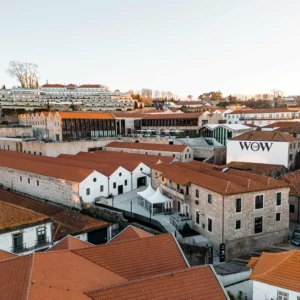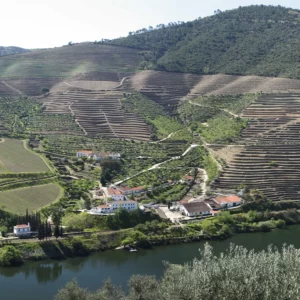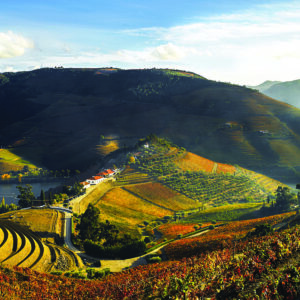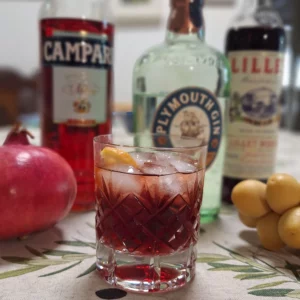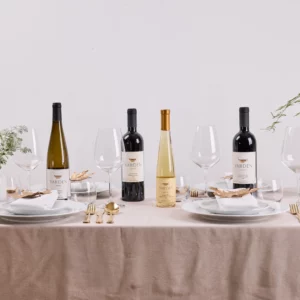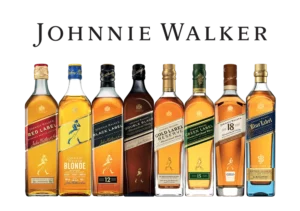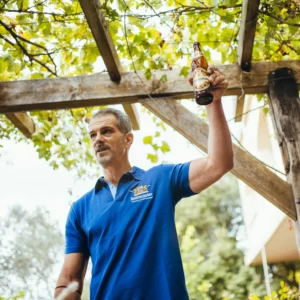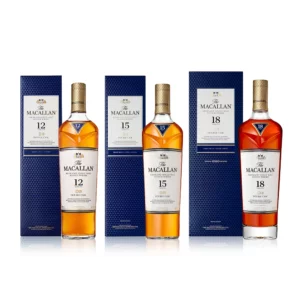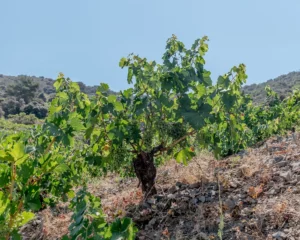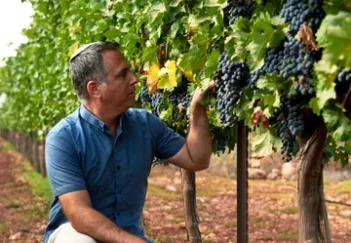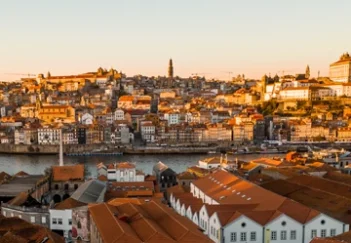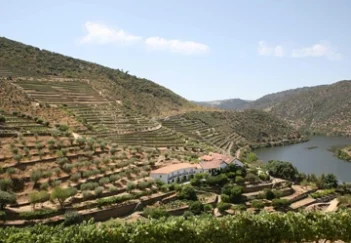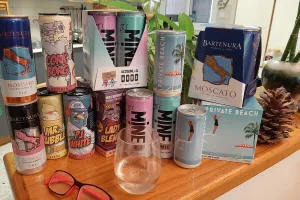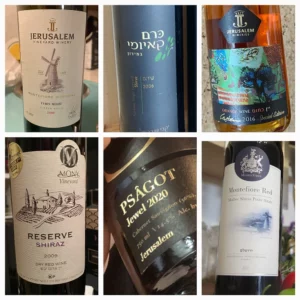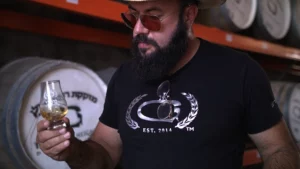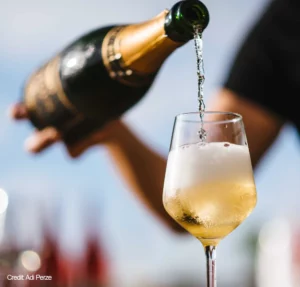Once a year we celebrate Tu Bishvat, the New Year for Trees. Children go on tree planting outings. Families will mark the festival by eating nuts and dried fruits. Those abroad will send donations for a tree to be planted in their name. This is the first festival of the new calendar year. Yet there is some dissonance with the timing. Why on earth do we observe Tu Bishvat in the winter? One would expect the spring to be a far more suitable time.
Of course, I am a wine guy, so I see everything through a prism of wine and vines. The vine buds in the early spring. The flowering occurs in late spring. Veraison, when the grapes change color, is in the summer. The harvest is in in the early autumn. Leaf fall will be in the late autumn. What happens in the winter? The answer is nothing that you can see. This is the vine’s quiet time and it is a dormancy period. After being pruned the vines will look like sticks in the ground standing straight like soldiers. The inexperienced onlooker may even look at a vineyard at this time and assume it is no longer alive. However the awakening always follows. Soon little buds will appear and the miraculous growing cycle begins yet again.
During those winter months, like the proverbial duck paddling furiously under water, the vine is working, but underground and out of sight. During the cold spells it is gathering strength and energy in preparation to be ready for the growing spurt in the spring. The very moment the ground has absorbed the winter rains, and the sap is beginning to rise, is when Tu Bishvat takes place. The festival is therefore the agricultural turning point between the previous year and next growing year. So Tu Bishvat signifies the beginning of the new year in the vine’s life cycle, though the optimum time to plant a vineyard is still in the spring.

The vine is one of the main symbols of Israel, from the time the spies in the Old Testament of the Bible came to Moses carrying a large bunch of grapes saying “It is a land of milk and honey and this is the fruit.” In the book of Deuteronomy it is written that the Land of Israel is “a land of wheat and barley, of vines, figs and pomegranates, a land of olive trees and honey.” These became the seven blessed species of the Land of Israel, which we will eat at Tu Bishvat. What is interesting, but not surprising, is that they each grow well in the Holy Land and require less water than many other fruit trees. They are listed in order of their ripening dates in the agricultural calendar. Of course the vine is represented by grapes or raisins, olive trees by olives and the honey mentioned was not from bees, but from dates.
Vineyards and olive groves produce wine and olive oil which have been partners, not only in the Holy Land from the time of the Israelites in the Bible to the Israelis in modern times, but also throughout the Eastern Mediterranean. The Greek historian Thucydides wrote that man became civilized when he planted the vine and olive tree. These have always been the main agriculture in the stony, poor soils of the area, in places where nothing else could grow. The old adage was plant fruit trees if you can, but if you can’t plant anything, try vines and olive trees! The best example of this is Domaine du Castel. The owner, Eli Ben-Zaken wanted to plant fruit trees around his house in Ramat Raziel. There was one area, on the slope from the house down to the chicken coop & stables, where the soil was too shallow and stony. There he planted vines in 1988, because he had no alternative. He made his first wine in 1992, because he had the vineyard, but he had not originally planted a vineyard to make wine. The rest is history and Castel became our most famous small winery.
There are areas of Israel, where the planting of vineyards staked out the land. The most obvious example is from 1882, when Baron Edmond de Rothschild invested in founding a modern Israel wine industry. He sponsored farmers of the First Aliyah, to plant vineyards in the valleys surrounding the southern slopes of Mount Carmel and in the central coastal plain, south east of Jaffa, and what is now Tel Aviv. There were many crops that were planted. They experimented with every kind of fruit tree and crop, but it was the planting of vineyards that succeeded in the Levantine climate. The vineyards became the symbol of the resettlement of Israel and Carmel Mizrahi became the main winery. When it became clear that growing vines required considerably less water than fruit trees, many farmers planted vineyards. As a result firstly the Golan, then the Galilee, Judea Foothills and Judean Hills, followed more recently by the Negev and Samaria, planted vineyards, and wine growing became each region’s most prominent agricultural activity.
Tu Bishvat is about so much more than trees. It is also a time to consider our surroundings. To talk, focus and provide education about caring for the environment. Wineries have stepped up too. In the last ten years, wineries have become more ecologically active. The Golan Heights Winery was the first Israeli winery to be certified sustainable internationally and they have chosen leaders of the field to collaborate with, in this instance Lodi Rules. Lodi Rules is California’s original sustainable viticulture program. It began ground up in 2005 with growers seeking to define new standards for their region. Lodi Rules promotes the adoption of over 120 sustainability standards which relate to soil management, ecosystem management, water management, pest management, business management and human resources. Whereas certified organic and biodynamic farming relate to the environment, certified sustainable farming is all encompassing and relates to the environment, the people and the business. Galil Mountain too, is one of the leaders of sustainability in Israel. They practice this not just in their Upper Galilee vineyards, but also at the winery, in the offices and in the local community. They have an ongoing waste reduction program with the slogan ‘reuse-reduce-recycle.’ The winery received most media coverage for its initiative to use recycled coffee from Nespresso capsules as part of its compost. These days Harashim from the Upper Galilee, Lotem from the Lower Galilee, Vortman from Mount Carmel and Neot Smadar from the Negev are examples of wineries producing organic wines.
Of course, the main focus of Tu Bishvat is trees, not vines. This respect for trees and the environment has stood Israel well. It is the only country in the world with more trees than one hundred years ago. An example of trees in the wine context is Yatir Forest. This is the meeting place between the Judean Hills, the Negev Desert and the Judean Desert. Israel’s first Prime Minister, David Ben Gurion, wanted to stop the advance of the desert and make the desert bloom. It was his idea to plant the forest. The experts told him in no uncertain terms, that it would not work. The trees would not survive. So, Ben Gurion impatiently said: “Change the experts!” The forest was planted beginning in 1964. It is today Israel’s largest planted forest. Nestling in the forest, at elevations of between 600 and 900 meters above sea level, are the prized vineyards of Yatir Winery, which is in itself situated at Tel Arad in the northeastern Negev. Vineyards for wine grapes were first planted there in 1996/7. Yatir Winery was founded in 2000, and their first wines were launched in 2004. This semi-arid, forest area has proved to be a unique terroir.
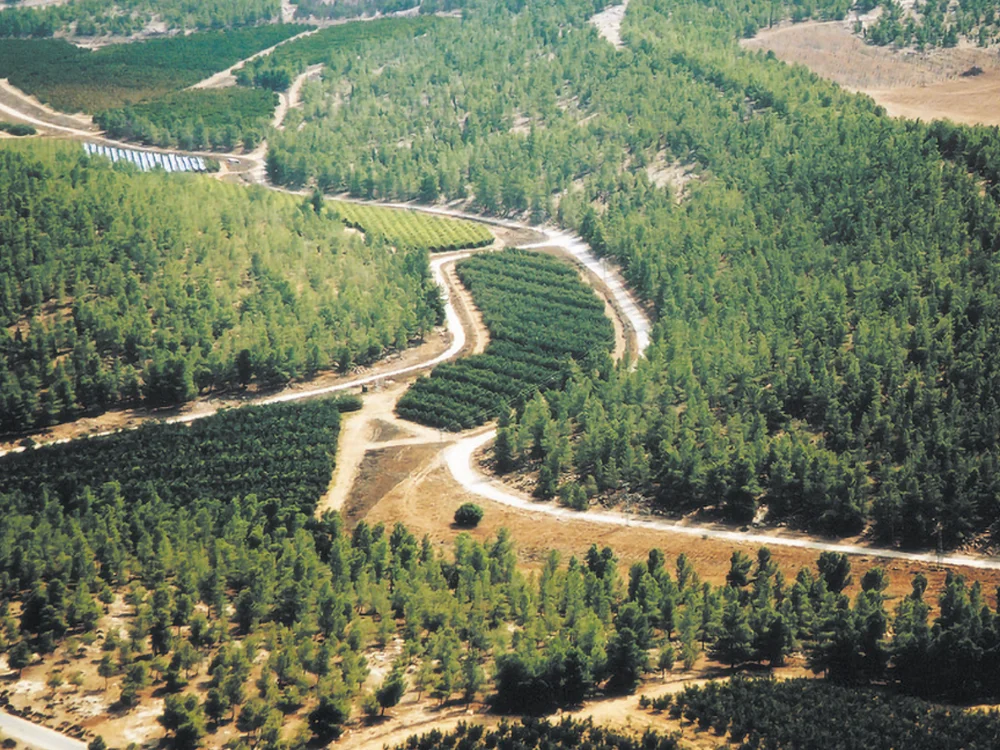
The Tu Bishvat festival may be celebrated with a Seder Meal, rather like the more well-known Seder Night at Passover. Whereas Passover is strictly followed according to tradition, Tu Bishvat gives an opportunity to be creative. On one level, it is a party to celebrate nature for children. On another it may be interpreted through Kabbalah to represent different states of existence, rebirth, creation and wholeness, and celebrated on altogether another level. Like at Passover, four glasses of wine are required, but in this instance, it is to celebrate the four seasons.
The first glass is a white wine to represent the bleak, dormant time of winter. The second is white wine with a splash of red in it, which represents the awakening of spring. The third is a red wine with a splash of white in it, to represent the blossoming and flowering. The fourth is a red wine to illustrate the fullness, ripeness and harvest of the late summer, early autumn.
These glasses of wine are accompanied by fruits of the Land of Israel. With the first glass, a fruit is served that is hard on the outside and soft on the inside. Examples include walnuts or almonds, but citrus, melon and bananas will also suffice. The next category of fruit with the second glass is soft with a pip in the center, like peaches, plums and apricots. The third category of fruit is soft throughout and totally edible, such as strawberries and raspberries. The fourth category of fruit is open to your own interpretation. I think it is appropriate for the fourth glass to focus on the Seven Species. Each grouping has its own symbolic value and meaning. To keep the theme of the Seder, a vegan or vegetarian meal may be served.

The minimum required for mixing or blending wines is one white and one red. It is recommended to use the entry level wines from one of the larger wineries, from brands such a Selected, Classic, Inspire, Hermon or Imperial (respectively from the largest wineries: Carmel, Barkan, Teperberg, Golan Heights and Zion.) For instance a Sauvignon Blanc and Cabernet Sauvignon will be adequate. If we are talking young families, maybe the low alcohol Moscato will be a more practical solution. These wines are low alcohol, frizzante and sweet. The largest five wineries all produce White Moscatos. Carmel, Teperberg and Zion also produce red and rose equivalents to provide the needed color. For young children, grape juice may be used. The traditional wineries: Arza, Carmel, Jerusalem, Segal, Teperberg and Zion all produce grape juice.
Tu Bishvat is a time to stop the daily rush and appreciate the world around us. Whatever is happening around the world, life in nature and the vineyard continues as before. This is the beginning of a new growing cycle. Let’s focus on nature for a moment, share the wonder with our children and appreciate all the trees, vineyards and olive groves in the Land of Israel.
Adam Montefiore is a wine trade veteran and winery insider turned wine writer, who has advanced Israeli wines for 38 years. He is referred to as the English voice of Israeli wine and is the Wine Writer of the Jerusalem Post. www.adammontefiore.com


